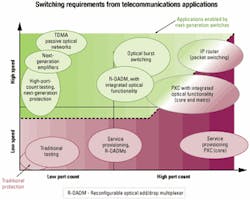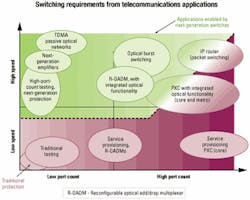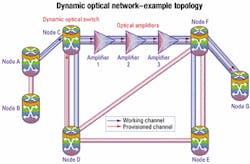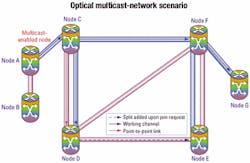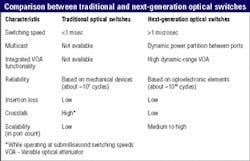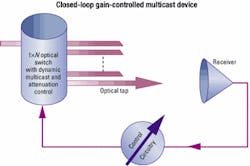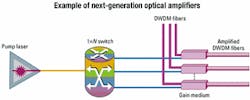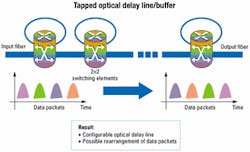All-optical switches: the evolution of optical functionality
A new generation of optical switches will benefit service providers, even in non-transmission applications.
ROY APPELMAN, JACOB VERTMAN, and JIM GOEDE, Civcom
Service providers today are seeking to deploy new, intelligent optical networks based on a new generation of optical components to decrease operational costs and increase revenues. These components are characterized by new optical functionality as well as multifunction integration.
One such component is the all-optical switch. The switch has evolved from a simple optomechanical device to an integrated component operating at higher speeds and incorporating new functionality. The addition of new capabilities, such as dynamic variable optical attenuation and optical multicast, into the optical-switch component, together with the increase in operating speed, offers significant advantages and enables a variety of new applications.
The Table on page 96 illustrates a comparison between next-generation optical switches and traditional devices. Next-generation components are characterized by better performance and additional optical functionality. This improved performance enables a plethora of new telecommunications applications (see Figure 1). Applications range from the introduction of new networking technologies to novel system implementations.
The establishment of SONET/SDH as the dominant transport technology has introduced some de facto standards in network protection schemes. The emerging practice has tended toward the use of dual homing (or no protection) in the network access, self-healing SONET/SDH rings in the MAN, and 1:1 or 1:N (primarily) linear protection in the long-haul.1 The evolution toward intelligent optical networks has led to the need for new, all-optical protection schemes to address a wide variety of network architectures such as rings, linked rings, hybrid mesh-ring, and mesh architectures.The integration of switching, multicast, and attenuation control is extremely useful when designing such protection schemes. For example, some of the most well-known ring protection schemes are unidirectional path-switched ring/2 (UPSR/2) and bidirectional line-switched ring/2 (BLSR/2). Recently, these schemes have been mapped into the optical domain to create optical-channel dedicated-path protection rings (OCh-DPRING, based on optical UPSR) and optical multiplexed section shared-protection rings (OMS-SPRING, based on optical BLSR) optical protection schemes.2
In the OCh-DPRING scheme (1+1 approach), each fiber carries wavelength channels in counter-propagating directions. The wavelengths are bridged at the headend, which provides the ability to perform receiver-based protection switching with little or no signaling. The use of the dynamic multicast function in the integrated optical switch can help in the design of an OCh-DPRING architecture. The power distribution capability compensates for the power loss incurred from bridging. Since the optical paths in both directions of the ring are seldom equal, a dynamic power distribution approach is more efficient.
Another method for improving efficiency is to lower the signal level below the standard operating signal-to-noise ratio (SNR). That allows for relatively fast and simple receiver-initiated protection schemes with minimal power penalty.
In the OMS-SPRING architecture, protection is performed at the fiber-span (OMS) level, which is more cost-effective in heavily multiplexed DWDM systems. The OMS-SPRING scheme is based on performing fiber loopback at the node adjacent to the failure.
In this scheme, two "virtual fibers" are created from the two physical ones. A wavelength assign ment/numbering scheme is used and the working and protection wavelengths are divided between the fibers. This approach implies that the traffic in each fiber (both working and protection) travels in opposite directions. The wavelength assignment ensures a reserved, protected wavelength for each working one.This scheme has the advantage of protecting the fiber rather than the optical channel. However, it suffers from the need to address the additional distance of the protection path and a more complex signaling protocol. The combined switching and attenuation control functions are necessary in this architecture to support a flexible wavelength assignment mechanism and create an efficient fiber loopback mechanism. These added bonuses increase when applying OMS-SPRING to four-fiber rings.
Integrated optical switches make ring-based schemes scalable to linked-ring, mesh-ring, and mesh architectures. Using fast optical switches with integrated gain control and multicast functionality enables the utilization of virtual protected ring architectures as an overlay over physical mesh networks.3 The result is fast restoration, enabling carriers to offer differentiated services.
It's also possible to mix different types of protection schemes. For example, it's possible to mix 1:N linear protection with ring-based protection mechanisms on one segment of the optical path so that a high-risk link can be protected with more costly 1+1 ring-based protection (such as OMS-SPRING), while using a more economical 1:N scheme for the rest of the path.
The rising customer demand for high-bandwidth data-oriented services, coupled with recent advances in optical technology, has led to the introduction of dynamic, "intelligent" optical networks. The intelligent optical layer offers various services such as dynamic channel provisioning, optical power monitoring, optical layer protection, and optical burst switching.
For both all-optical and optical-electrical-optical (OEO)-based networks, these new features create a DWDM network capable of dynamic wavelength allocation. The control plane for these types of networks may be based on network-management systems, Generalized MPLS, or an optical burst switching variant. However, the optical functionality required in all cases is similar.
Dynamic wavelength allocation creates the need to better adapt to changes in the physical layer in the network. To illustrate, the network model in Figure 2 will be used. A steady-state network topology that includes single-wavelength connectivity between nodes A and G via nodes C and F is shown. At a given time, an additional wavelength is lit between nodes D and G. The effects of introducing a new wavelength differ for an OEO-based network and an all-optical network.In OEO networks, the wavelength is terminated at every node. That limits the optical effects to each link traversed by the wavelength. It also allows for simple equalization of optical power at every link (transmitter output power). Therefore, in OEO-based networks, the transient effects are limited to the optical amplifiers.
For example, the new wavelength between nodes D and G causes an increase in optical power at the input to amplifier 1, resulting in 3-dB less gain to the connected channel. The decrease in optical power doubles at amplifiers 2 and 3, causing a significant decrease in power at the receiver in node F. As a result, a loss-of-service alarm and protection switch may occur. To avoid this problem, the amplifiers along the link must be able to adapt to changing input power. The integrated optical switch allows for the design of such a device.
In the all-optical case, the new wavelength that arrives from node D follows a different optical path than the one from node A. Hence, a difference in optical power results at the input to node C, yielding several possible effects:
- An increase in optical power at the input to amplifier 1, resulting in decrease of gain to connected channels.
- Crosstalk between channels due to non-linear effects in the optical amplifier and optical fiber.
- Crosstalk between channels in the optical crossconnect (OXC) due to insufficient isolation.
Switch operation speed is also important. Lighting new wavelengths must be performed either very quickly or very slowly and incrementally. Fast operation allows the optical path to stabilize before protection mechanisms are triggered. That requires stabilization times in the submillisecond range (system implementation-dependent), which may not be possible with all-optical components.
Incremented operation lights up the wavelength in small power increments. The effect of each individual increment on the previously connected channels is negligible; therefore, stabilizing times per increment may be relaxed. The drawback is the length of time needed for setting up a connection and the added complexity to the overall process.
The multicast concept for packet-oriented networks has been widely studied in the past because of the exponentially increasing number of bandwidth-intensive applications. By extending the concept to the optical domain, packet-based applications such as broadband video, high-definition TV, storage-area networks, and multimedia can be provided with enhanced performance. In addition, other benefits such as optimizing the network (minimizing transceiver usage in the network, maximization of the "virtual" connectivity between the network nodes, wavelength grooming, minimizing the number of wavelengths, etc.) can be realized. That has led to recent interest in optical multicast-capable networks.4,5,6
Optical multicast refers to point-to-multipoint connections that are created using light-trees (see Figure 3). All-optical multicast refers to distribution of the optical input power between the various output ports of the node.
To illustrate some of the benefits that may be gained from optical multicast, the example illustrated in Figure 3 will be used. A single wavelength is shown connecting nodes A, D, F, and G; notice that node C is simply splitting the light, while node F is performing a drop-and-continue function. Assuming adequate optical budget, this same wavelength could connect node E as well (upon reception of a join request). Only one transmitter and four receivers are needed for this configuration.To achieve the same connectivity using an OEO configuration would require five transmitters and five receivers as well as high-bandwidth electronic switching. An all-optical connection using point-to-point light paths would require four transmitters and four receivers as well as four different wavelengths due to the shared link between nodes A and C.
These benefits have a cost. The realization of an optical multicast architecture must balance several conflicting design and performance criteria, including:
- Minimizing the number of nodes traversed.
- Minimizing some combination of the number of transceivers, optical amplifiers, and OEO regenerators in the network.
- Maximizing the virtual connectivity between the network nodes.
- Maintaining an operable optical power budget.
- Solving the routing and wavelength assignment (RWA) problem for both unicast and multicast connections that may exist side by side.
- Minimizing the wavelength blocking probability.
The optical switch with integrated multicast and gain control is a key device in the implementation of dynamic, all-optical, multicast-capable networks. They can help solve one of the primary design problems in optical multicast networks: managing the optical power budget. Since optical multicast inherently involves the distribution of the optical power among several client nodes, a power penalty is incurred. Flexible, dynamic power distribution keeps these losses to a minimum, while maximizing the efficiency of the network.
In addition, when adding or removing a node from the multicast tree, the reaction time of the switch is important. For example, in the network scenario described in Figure 3, upon reception of a join request from node E, power must be allocated along the optical path (in the tree) from node A to E. To assure network stability, it's imperative that the active connections to nodes D, F, and J are not disturbed. A closed-loop device operating at submicrosecond speeds can minimize the effects of optical power transients on the active connections (see Figure 4).
The evolution of the optical layer, as detailed earlier, has led to dynamic optical-channel provisioning. Additionally, a large installed base of dark fibers is available for future requirements. As a result, optical amplifiers must adapt to the new situation where both wavelengths and fibers are provisioned dynamically.The integrated functionality of the next-generation optical switch enables economical adaptation of the optical amplifier to this situation. Figure 5 shows an amplifier architecture that details such an adaptation. A single pump laser is used to excite a number of doped fibers. The optical switch with multicast and gain control functionality manages the power distribution between the interaction modules. That allows for the provisioning of gain modules for "dark" fibers. Using appropriate control-plane signaling, gain may be provided to these dark fibers at will.
This architecture allows for gain control of existing optical channels in lit fibers as well as economic provisioning of dark fibers. For example, to provide gain to M active fibers as well as provision N-M "dark" ones, only one pump laser coupled to a 1xN-integrated switch is required. Using traditional amplifiers would require N pump lasers as well as N variable attenuators to manage the gain control.
SONET/SDH rings are the most common topology in MANs today. The large installed base of fiber rings requires that any development in metro communications systems take that into account. That means DWDM technology will initially be deployed over ring architectures, with more economic hybrid mesh-ring and mesh architectures installed as overlays.
Reconfigurable optical add/drop multiplexers (R-OADMs) are essential for deploying dynamic DWDM systems in ring architectures. The ability to reconfigure wavelengths quickly with no constraints allows carriers to dynamically provision their networks, thereby quickly realizing new revenue. All-optical reconfigurability also provides an easy migration path to more complex ring-mesh and mesh architectures.The evolved optical switch provides much-needed optical functionality to the R-OADM. The switch provides the add/drop functionality. The gain control assists in wavelength reconfiguration, while the multicast functionality provides a much-needed drop-and-continue function. Drop-and-continue is essential for provisioning wavelengths along interconnected rings and sharing a single wavelength's bandwidth between nodes and for some protection architectures. While the evolved all-optical switch serves an enabling technology for many telecommunications applications, it can be used in non-telecom roles as well. Using the switch in the optical setup described in Figure 6 results in a tapped delay line that may be used as an optical buffer, temporal switch between packets, or the simulation of temporal multipath for radio-frequency-testing applications.
Optical switches may also be used in a variety of test equipment. When performing time-consuming tests such as polarization-dependent-loss or insertion-loss measurements on a multiport optical system, significant time savings can be realized during manufacture by using fast, reliable optical switches (with or without multicast capability) to switch between the systems ports and test equipment.
The evolution of the optical switch into a multifunctional all-optical device has enabled numerous novel applications that could not have been realized previously. These applications range from new networking applications such as dynamic all-optical networks and optical burst switching to test equipment and delay lines. Next-generation infrastructures built on these applications will provide new and useful services at a significantly lower cost.
- S. Ayandeh, P. Veitch, "Dynamic Pro tection and Restoration in Multilayer Networks," OIF 2001.166, April 2001.
- N. Ghani et al., "Architectural Fram work for Automatic Protection Provi sioning in Dynamic Optical Rings," OIF 2001.041, January 2001.
- R. Doverspike, J. Yates, "Challenges for MPLS in Optical Network Restoration," IEEE Communications February 2001.
- D. Papadimitriou et al., "Optical Multi cast-A Framework," OIF2001.093, April 2001.
- B. Mukherjee et al., "Light Trees: Optical Multicasting for Improved Performance in Wavelength Router Networks," IEEE Communications Magazine, February 1999.
- D. Papadimitriou et al., "Optical Rings and Optical Hybrid Mesh-Rings Topolo gies," Internet draft, work in progress, draft-papdimitiou-optical-rings-00.txt, February 2001.
Roy Appelman ([email protected]) is director of system engineering, Jacob Vertman ([email protected]) is vice president of business development, and Jim Goede ([email protected]) is director of product marketing/business development at Civcom Inc. (Gilroy, CA, and Petach-Tikva, Israel).
